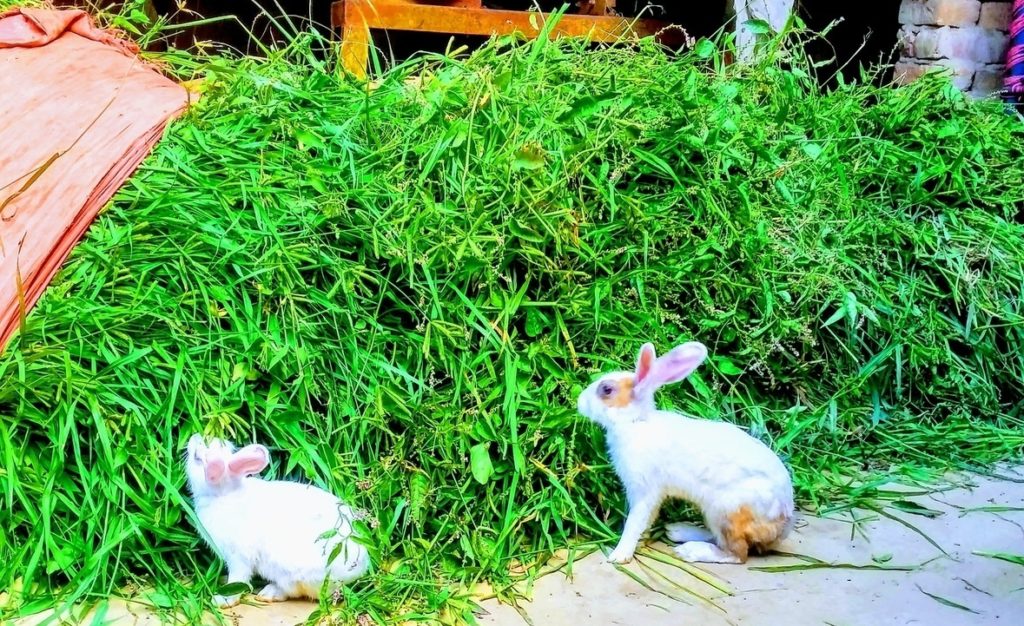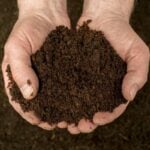
Cows eat grass. Horses graze on grass in pastures. Once in a while, even your pooch snacks on lawn greenery. So it’s not surprising many people wonder if feeding lawn clippings to their livestock or pets are safe. The truth may come as a shock!
Feeding lawn clippings from your grass to your animals can be dangerous. Some animals tolerate it. Clippings may sicken or kill other animals.
Feeding Animals Grass Clippings
In theory, it seems like a safe idea, right? Instead of bagging up and throwing away the debris from mowing, or raking up a pile of grass clippings to compost, it seems completely acceptable to offer the clipping to our animals as a special treat. Unfortunately, danger lurks depending on the time lapsed from mowing to the offering of such goodies as well as the amount offered.
Before ever allowing an animal in your charge to eat grass, you need to know its type. As an edible material, grass has four stages:
- Live grass.
- Freshly cut grass.
- Drying (fermenting) grass.
- Dried grass.
Animals have dramatically different tolerances for the grasses at different stages. It’s important to know when it’s safe to feed them to your livestock and other animals — and when to avoid it.
Avoid Fermentation
Many animals can safely nibble on small amounts of live grass, including dogs and cats. Some animals — ruminants, including cows, sheep, goats, giraffes and camels — have even evolved to digest large amounts of it.
But once grass is mowed, a change quickly takes place. Grass, which is 80% water, begins fermenting within hours, especially in humid environments. Anyone who has piled clippings or bagged them in a black trash bag can attest to this. It doesn’t take long for them to get hot and take on a sickly sweet smell as it produces ethanol.
When an animal eats the clippings, they continue to ferment in the animal’s gut, making animals ill. According to Juliet Getty, an expert horse nutritionist, a dense pile of grass clippings also favors the development of deadly botulism because of a lack of oxygen.
Therefore if you are going to feed grass clippings, they should be offered immediately before fermentation begins, or when they have completely dried down.
Small to Moderate Amounts May Be OK
Related to the amount offered is the sheer amount of carbohydrates found in lawn clippings. Grass contains a large amount of sugar compared to other animal feeds. In essence, grass contains three types of sugars: glucose, fructose, and fructans which form when several molecules of fructose bind together. Fructans are not digested in the stomach and small intestine; when large amounts pass into the hindgut they wreak havoc.
Finely chopped grass clippings are often consumed in hefty quantities. Giving them to animals in small amounts is often a safer bet.
How Different Animals Tolerate Lawn Clippings
Let’s talk about specific animals, whether they should be fed lawn clippings and how eating grass affects them:
Horses: No!
Feeding grass clippings to your horses is incredibly problematic. Many large-animal veterinarians report they must address this as a horse-care issue often through the spring and summer.
Horses will gorge themselves on the sugar-laden morsels, often neglecting to even chew the finely chopped pieces of mower clippings. Their digestive systems are designed to digest fiber slowly; they use their teeth to break down food into small particles, releasing saliva as they chew to begin the digestion process which finishes, slowly, in the intestines.
When clippings are swallowed without being chewed, it causes the starch/sugar bacteria in the hindgut to go into overdrive, producing an increased level of lactic acid. This lactic acid lowers the pH of the hindgut, killing the fiber digesting bacteria, releases toxins, and induces an inflammatory reaction in your horse(s) that can cause colic and laminitis. Fermented grass containing lactic acid only acts to accelerate this process.
In one case, reported in April 2019 in the Wahpeton (North Dakota) Daily News, a horse that chowed down on lawn clippings had to have 15 buckets of fermenting grass pumped out of its stomach.
“It’s an all too common emergency this time of the year,” writes by Lori Ricigliano, a horse judge and equestrian trainer who operates Ricigliano Farms Horse Training and Riding Academy near Kent, Minn. “A well-meaning neighbor throws his fresh lawn clippings over the fence for the neighbor horses to have a treat. Unfortunately, this treat can turn deadly. ”
Feed horses only small piles of grass that have been allowed to dry down completely. For optimum horse health, limit their intake to pasture grass within their paddock.
Cattle: Yes, if Fresh-Mowed or Fully Fermented
Cattle, on the other hand, can safely consume fresh grass clippings as long as they do so within 8 hours of mowing. This is when fermentation and decomposition begin. During fermentation, cattle tend to avoid them, but once the clippings have gone through ensiling — where sugars are fermented into organic acids — the resulting silage can be consumed.
In a fairly new venture, a Wyoming based landscape company has developed a landscape waste compactor that converts lawn clippings into cattle-safe silage in about 28-days. The process takes clippings into 1-ton poly-lined, sealed sacks and allows the biomass to ferment into usable livestock silage.
Sheep: Yes, if Fresh-Mowed or Fully Fermented
Grass clippings can be used as a feed source for sheep, says research from Colorado State University’s Cooperative Extension. When used as a supplement with grain, fresh clippings resulted in acceptable daily weight gains and carcass traits at less cost per pound of gain than conventional diets.
Similar to cattle, either feed fresh clippings or allow them to complete the fermentation process before offering small amounts to your sheep.
Goats: Yes, if Fresh-Mowed or Fully Fermented
With goats, follow the same protocol as sheep: feed small amounts of newly mowed clippings or allow them to dry completely. Make sure to never feed them partly dried clippings, and avoid offering them as a food source unless your goats are used to pasture grass already.
As an aside, getting your goats to actually eat lawn clippings is hit or miss, even when fresh. Some devour the treat and others ignore them completely.
Chickens: Yes, in Small Amounts, if Finely Mulched
Chickens love to eat grass and are known for wandering around a lawn, nipping off tiny bits of the blades of grass to munch on. Feeding them lawn clippings can be counterintuitive though unless they are finely mulched.
With a nonmulching mower, the portion of grass cut off during mowing is often too long to safely feed chickens. The fibrous strands of the pieces can get balled up, causing a blockage in the crop — the expanded, muscular pouch near the gullet or throat.
If you choose to feed them to your chickens, offer small, scattered amounts, finely mulched.
Rabbits: No!

Avoid feeding rabbits grass clippings. They upset rabbits’ digestive systems and cause an illness known as GI stasis.
Guinea Pigs: No!
In tiny nibbles, grass is an important part of a guinea pig’s diet to help maintain healthy gut mobility, but as with rabbits, avoid feeding your pigs grass clippings. If the grass has begun to ferment it upsets the delicate balance of bacteria within their digestive systems.
So the next time you cut grass, think twice about feeding animals grass clippings to avoid a headache for you — and stomachache for them.





